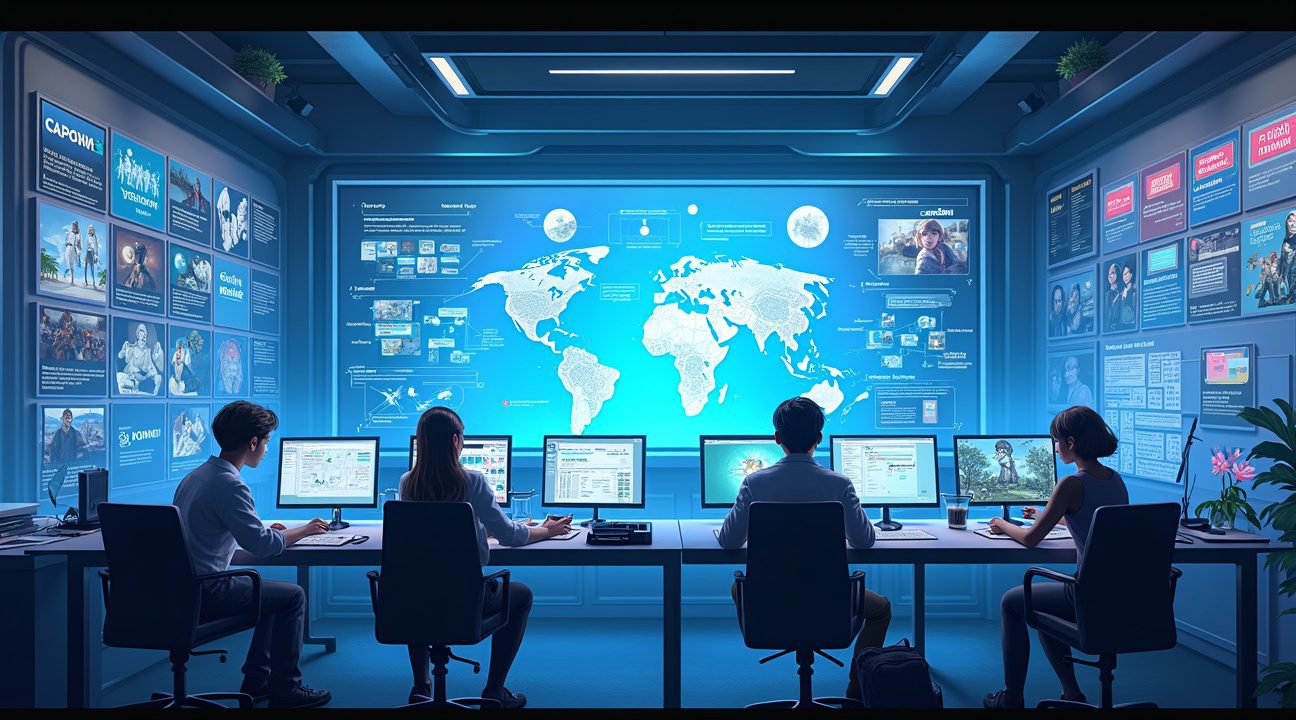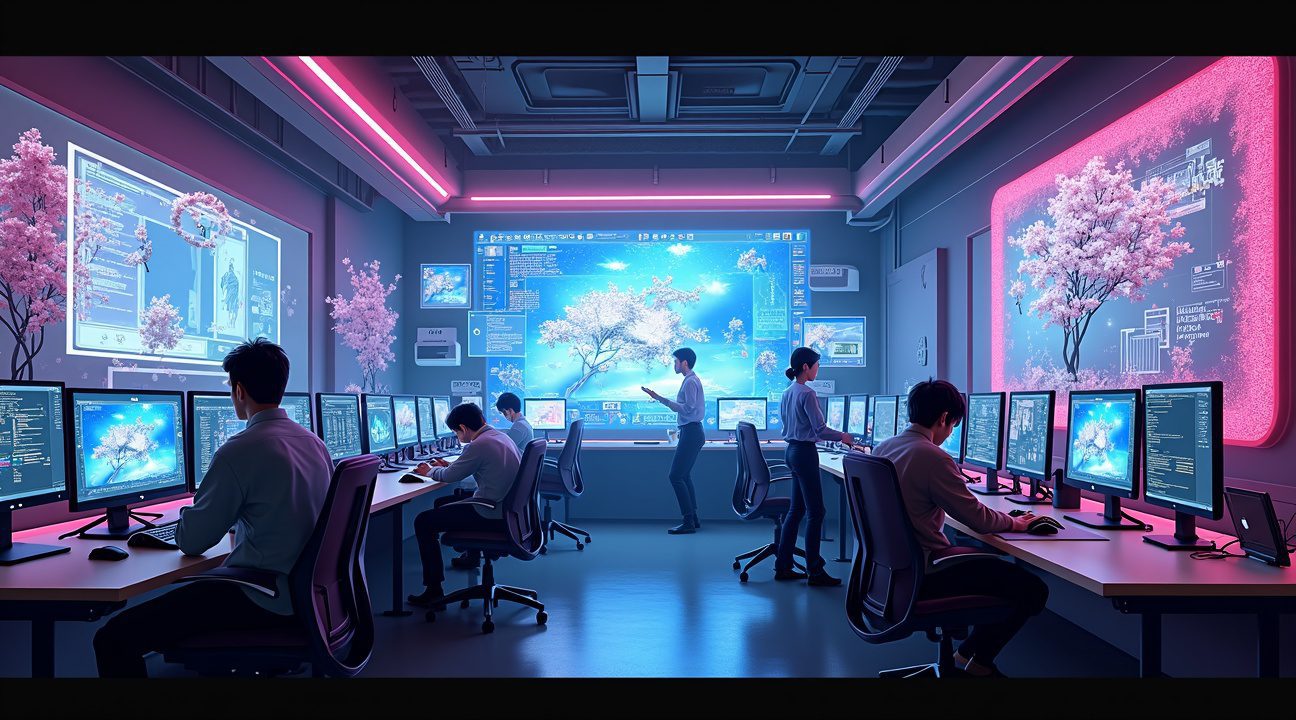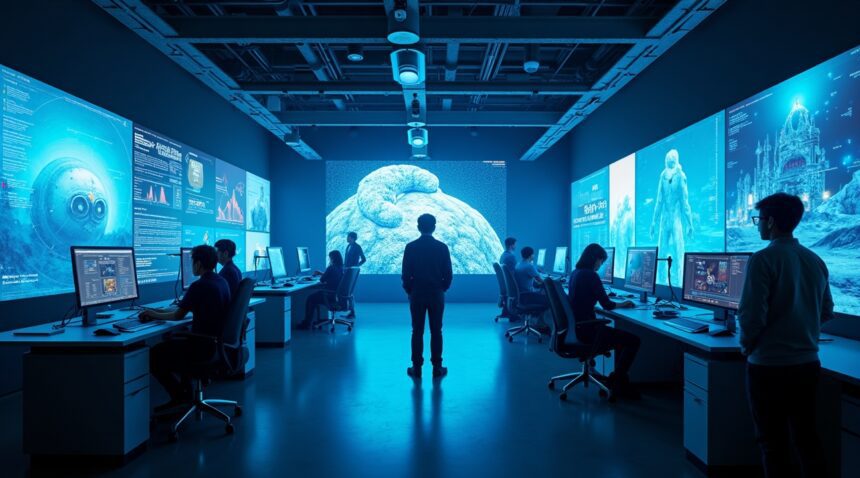The Computer Entertainment Supplier’s Association’s 2025 survey reveals that 51% of Japanese game developers now integrate generative AI into their workflows, marking a pivotal shift from experimental use to practical implementation across the industry.
Key Takeaways
- Over half of Japanese game developers have moved beyond experimentation to actively using generative AI in production workflows, with major studios like Capcom, Sega, Konami, and Square Enix leading adoption efforts.
- AI integration spans multiple development areas including concept art generation, dialogue writing, asset optimization, and code creation, with Level-5 reporting AI assistance for 80-90% of their programming tasks.
- The Japanese gaming industry’s adoption rate of 51% far exceeds the national average of 26-27%, demonstrating how competitive pressure and innovation culture drive faster technology integration in creative industries.
- Despite widespread adoption, significant barriers remain including legal uncertainty around copyright issues, data privacy concerns, and talent shortages, with Nintendo notably maintaining a cautious stance on AI implementation.
- Japan’s AI market is projected to grow from $6.6 billion in 2024 to $35.2 billion by 2033, with gaming industry success serving as a potential catalyst for broader adoption across other sectors.
AI Implementation by Major Studios
Major Japanese gaming companies have embraced AI technology with remarkable speed. Capcom leads the charge by implementing AI-powered asset generation systems that accelerate character design workflows. Sega deploys machine learning algorithms to optimize game performance and create dynamic difficulty adjustments. Square Enix utilizes AI for procedural content generation and narrative branching systems. These implementations demonstrate practical applications rather than theoretical experiments.
Level-5’s Advanced AI Integration
Level-5’s extraordinary achievement of AI-assisted programming for 80-90% of their development tasks showcases the technology’s transformative potential. Their engineers report significant time savings in code debugging, optimization routines, and automated testing procedures. This level of integration represents a fundamental shift in development methodology.
Creative Applications in Game Development
Creative applications dominate current AI implementations. Concept artists now collaborate with AI systems to generate initial sketches, environmental designs, and character variations. Writers employ AI assistants for dialogue generation, plot development, and localization tasks. Sound designers experiment with AI-generated audio effects and musical compositions. These tools amplify human creativity rather than replace artistic vision.
Technical Deployment Strategies
Technical implementation varies across studios. Some companies deploy cloud-based AI services for flexibility and scalability. Others build in-house systems for greater control and customization. Hybrid approaches combine both strategies, using external services for general tasks while developing specialized internal tools for proprietary workflows.
Legal and Regulatory Challenges
Legal challenges persist despite rapid adoption. Copyright uncertainties surrounding AI-generated content create hesitation among developers. Questions about training data ownership and derivative work rights remain unresolved. Privacy regulations add complexity to data handling procedures. These concerns explain Nintendo’s conservative approach to AI integration.
Industry Context and Market Forces
Market dynamics drive adoption rates beyond national averages. International competition forces Japanese studios to innovate rapidly or risk falling behind global rivals. Mobile gaming demands quick content updates that AI systems can facilitate. Rising development costs make efficiency gains through automation increasingly attractive. Consumer expectations for personalized gaming experiences push studios to explore AI-powered customization.
Training and Education Efforts
Training requirements represent both opportunities and obstacles. Developers must acquire new skills to work effectively with AI systems. Studios invest heavily in education programs and workshops. Universities adapt curricula to include AI development courses. This knowledge gap creates temporary bottlenecks but promises long-term advantages for early adopters.
Economic Outlook and Cross-Industry Influence
Economic projections paint an optimistic picture for Japan’s AI future. The gaming industry’s success demonstrates practical AI applications that other sectors can emulate. Manufacturing companies observe gaming implementations for potential factory automation insights. Entertainment conglomerates study content generation techniques for film and television production. This cross-pollination effect could accelerate nationwide AI adoption.
Proven Benefits and Performance Impact
Performance metrics validate AI integration benefits. Development cycles shrink as automated systems handle routine tasks. Quality assurance processes become more thorough through AI-powered testing. Localization projects complete faster with machine translation assistance. These measurable improvements justify continued investment in AI technology.
Looking Forward
Looking ahead, the 51% adoption rate signals just the beginning of AI transformation in Japanese gaming. Studios continue expanding AI applications into new areas like player behavior analysis, monetization optimization, and community management. This momentum positions Japan’s gaming industry as a global leader in practical AI implementation, potentially inspiring similar adoption rates across other creative industries.
CESA Survey Reveals 51% of Japanese Game Developers Now Use Generative AI
The Computer Entertainment Supplier’s Association (CESA) has documented a significant milestone in their 2025 survey, revealing that over 51% of Japanese game developers now integrate generative AI into their development workflows. This figure represents a fundamental shift from experimental curiosity to practical implementation across the industry.
Major Studios Lead the Adoption Wave
Industry giants including Capcom, Sega, Konami, and Square Enix have embraced AI tools as part of their standard development processes. These companies recognize that artificial intelligence is paving the way for more efficient game creation. The technology spans multiple development areas, from concept art generation to dialogue writing and asset optimization.
Independent studios haven’t lagged behind in this technological adoption. Many smaller developers leverage AI tools to compete with larger teams, using generative technology to produce high-quality assets without expanding their workforce significantly. This democratization of content creation tools has leveled the playing field between major publishers and indie developers.
Industry Transformation and Notable Exceptions
The widespread acceptance signals that Japanese developers view AI as a collaborative tool rather than a replacement for human creativity. Studios report using AI for rapid prototyping, texture generation, and initial concept exploration while maintaining human oversight for final creative decisions. The technology has become particularly valuable for handling repetitive tasks and generating multiple iterations quickly.
Nintendo stands as a notable exception to this trend, maintaining a cautious stance toward generative AI integration. The company hasn’t joined the current adoption wave, preferring to observe how the technology develops before making significant commitments. This conservative approach reflects Nintendo’s traditional preference for proven technologies and their focus on proprietary development methods.
The survey results indicate that Japanese game development has reached a tipping point where AI tools are transitioning from novelty to necessity. Companies report improved efficiency in pre-production phases and faster iteration cycles when developing game concepts. The technology has proven especially useful for generating environmental assets and background elements that would traditionally require extensive manual creation.
This mainstream adoption across Japan’s gaming industry suggests that generative AI has moved beyond the experimental phase. Developers increasingly view these tools as essential components of modern game development, similar to how 3D modeling software became standard decades earlier. The trend indicates that new AI capabilities will continue reshaping creative workflows across the entertainment industry.

How Game Studios Are Integrating AI Into Their Development Workflows
Japanese game studios aren’t just experimenting with generative AI—they’re strategically weaving it into their core development processes. I’ve observed how these forward-thinking companies are transforming traditional workflows through careful AI integration across multiple production areas.
Visual Asset Creation and Character Development
Visual asset creation stands as the most prominent use case for AI integration in Japanese studios. Developers are leveraging generative AI to produce concept art, environmental assets, and character designs with remarkable efficiency. Artists use AI tools to rapidly generate initial concepts and variations, then refine these outputs through traditional artistic methods.
Character and story design applications have emerged as another critical area where studios apply AI technology. Writers and narrative designers employ AI to craft in-game dialog, develop branching storylines, and create compelling character backstories. This approach allows creative teams to explore multiple narrative possibilities quickly while maintaining the human touch that defines memorable gaming experiences.
The evolution of AI-generated content has opened new possibilities for cutscene creation and promotional materials. Studios can now prototype entire sequences before committing significant resources to full production.
Programming and Engine Development
Level-5’s approach to AI-assisted programming demonstrates the transformative potential of generative AI in code creation. The studio reports using AI for 80-90% of their code writing processes, fundamentally changing how programmers approach development tasks. This dramatic shift allows human developers to focus on complex problem-solving and creative implementation rather than routine coding work.
Proprietary game engine and tool development represents another significant integration point, with approximately one-third of studios incorporating AI into these specialized areas. Engineers use AI to:
- Generate boilerplate code
- Optimize existing systems
- Create custom development tools that streamline production workflows
The growing influence of AI extends beyond simple code generation. Studios employ AI for debugging assistance, performance optimization suggestions, and even architectural planning for complex game systems.
AI accelerates prototyping phases by enabling rapid iteration on gameplay mechanics, visual styles, and technical implementations. Developers can test multiple approaches simultaneously, comparing AI-generated alternatives against traditional methods to identify optimal solutions.
Creative asset generation through AI has revolutionized how studios approach resource-intensive tasks like texture creation, model generation, and animation sequences. Teams can produce initial assets at unprecedented speeds, then allocate human expertise to refinement and quality enhancement.
Programming assistance through AI tools helps developers write cleaner code, identify potential bugs before deployment, and maintain consistent coding standards across large development teams. The technology serves as an intelligent assistant rather than a replacement, augmenting human capabilities while preserving creative control.
Common applications span entire production pipelines, creating interconnected workflows where AI contributes to:
- Asset generation
- Story development
- Tool creation
- Quality assurance testing
Studios report significant time savings in areas previously considered bottlenecks, allowing teams to focus on innovation and player experience rather than repetitive tasks.
The competitive landscape of AI tools gives developers multiple options for integration, encouraging experimentation and specialized implementations across different project requirements.
Testing procedures now incorporate AI to generate test cases, simulate player behavior patterns, and identify potential gameplay issues before release. This comprehensive approach ensures higher quality outputs while reducing the manual effort required for thorough game testing.
Japanese studios continue refining their AI integration strategies, balancing efficiency gains with creative integrity. The technology enhances human capabilities rather than replacing them, creating collaborative workflows where artificial intelligence amplifies creative vision and technical expertise.
Japanese Game Industry Leads National AI Adoption Compared to Other Sectors
I’ve observed a striking divergence between Japan’s game development sector and the broader national adoption of generative AI technologies. The 51% adoption rate among Japanese game developers represents a dramatic outlier in a country where only 26-27% of the general public and business sectors have embraced generative AI as of 2024.
This disparity becomes even more pronounced when examining Japan’s position on the global stage. The nation trails significantly behind international competitors, with China achieving an 81% adoption rate and the United States reaching 69%. Japan’s overall performance indicates substantial room for growth in the artificial intelligence landscape.
Corporate adoption patterns reveal similar challenges across most Japanese industries. Just under 50% of Japanese companies nationwide had formulated plans to adopt generative AI in 2024, placing them behind global averages. However, the gaming sector’s leadership demonstrates that certain industries can successfully integrate these technologies despite broader national hesitation.
Demographics Drive Adoption Patterns
Government and industry surveys consistently identify specific patterns among early adopters. Younger demographics show significantly higher enthusiasm for generative AI implementation, reflecting their comfort with emerging technologies and digital innovation. This trend aligns perfectly with the gaming industry’s workforce composition, where younger developers often drive technological advancement.
Larger firms consistently outpace smaller organizations in adoption rates across all sectors. These companies possess the resources necessary for AI integration, including:
- Dedicated research budgets
- Technical infrastructure
- Specialized personnel
Their ability to experiment with competing AI platforms gives them competitive advantages in implementation speed and effectiveness.
The gaming industry’s success with generative AI adoption stems from several factors that distinguish it from traditional Japanese business sectors:
- Regular work with cutting-edge technology encourages experimentation.
- The creative nature of development offers visible applications for AI—such as character design and procedural world generation.
- The culture within gaming prioritizes innovation and rapid iteration.
Cultural factors within Japan’s business environment may explain the slower adoption rates outside gaming. Traditional corporate structures often emphasize consensus-building and risk aversion, potentially slowing technology adoption. The gaming industry operates with different cultural norms, prioritizing innovation and rapid execution—a mindset that aligns well with AI experimentation.
International competition pressures also accelerate gaming industry adoption. Japanese game developers compete directly with studios worldwide, creating urgency around technological advancement. This competitive environment contrasts sharply with more domestically focused industries where international pressure remains less immediate.
The success of video generation tools particularly resonates within gaming, where visual content creation represents a significant portion of development costs. Generative AI offers substantial productivity gains in areas like:
- Concept art
- Texture generation
- Animation assistance
These improvements provide a clear return on investment that justifies adoption.
Looking ahead, the gaming industry’s leadership position could influence broader Japanese adoption patterns. Success stories from game development studios may encourage other sectors to reconsider their AI strategies. The industry serves as a testing ground for applications that could eventually spread to other creative and technical fields.
Government surveys suggest that awareness campaigns and success demonstrations could accelerate adoption across other sectors. The gaming industry’s documented benefits provide concrete examples of AI implementation that other Japanese businesses can study and potentially replicate in their specific contexts.
AI Integration Drives Innovation and Market Growth in Japanese Gaming
Generative AI has transformed how Japanese game developers approach their craft, enabling rapid prototyping that previously required weeks to accomplish in mere days. This acceleration allows studios to experiment with multiple concepts quickly, testing gameplay mechanics and visual designs without the traditional time investment. AI technology reduces routine workload by automating repetitive tasks like texture generation, basic animation sequences, and level geometry creation.
The creative enhancement aspect proves particularly valuable as developers use AI to generate initial concept art, iterate on character designs, and explore narrative possibilities. Game studios report that AI serves as a catalyst for innovation, helping teams break through creative blocks and explore directions they might never have considered. This technological shift enables developers to focus their human expertise on high-level design decisions and creative direction rather than getting bogged down in time-consuming technical tasks.
Early adopters of AI integration gain significant global competitiveness advantages through faster development cycles and higher-quality output. Studios implementing AI tools report dramatic improvements in their ability to meet tight deadlines while maintaining creative standards. The speed increase translates directly into cost savings, allowing companies to allocate resources more efficiently across projects.
Market Growth Reflects AI’s Economic Impact
Japan’s AI sector reached $6.6 billion in 2024, with industry forecasts targeting $35.2 billion by 2033, signaling sustained rapid expansion across multiple sectors including gaming. This growth trajectory reflects both domestic adoption and international recognition of Japanese AI innovations. Time and cost savings emerge as the primary benefits cited by developers, with many reporting project timeline reductions of 30-50% for certain development phases.
Video generation capabilities particularly excite game developers for creating cutscenes and promotional materials. The technology enables small teams to produce content that previously required extensive animation departments. However, developers emphasize that AI functions as an accelerator rather than a full replacement for human creativity and oversight, maintaining the importance of responsible integration practices.
Industry trends show the formation of internal AI committees at major companies like Sega, which establish guidelines for ethical AI use and evaluate new tools. These committees ensure that AI implementation aligns with company values while maximizing productivity benefits. The rise in proprietary AI tools reflects studios’ desire to maintain competitive advantages through customized solutions that address specific game development challenges.
Competition between AI platforms drives continuous improvement in tools available to developers. Studios benefit from this competitive landscape through better features, lower costs, and more specialized gaming applications. Many companies develop hybrid approaches, combining multiple AI tools to create comprehensive development pipelines.
Ethics remains a central focus as studios navigate questions about AI-generated content ownership, artist employment, and maintaining human creative input. Japanese developers emphasize preserving the human element that makes games emotionally resonant while leveraging AI’s efficiency gains. This balanced approach helps maintain industry credibility while embracing technological advancement.
The integration process involves extensive training programs to help development teams understand AI capabilities and limitations. Creative industries worldwide watch Japan’s approach closely as a model for responsible AI adoption. Studios report that successful integration requires clear workflows, defined human oversight points, and continuous evaluation of output quality.
Technology companies increasingly partner with game studios to refine AI tools for creative applications. These collaborations result in more intuitive interfaces and better understanding of developer needs. Creative professionals across industries share similar concerns about AI’s role, with Japanese game developers leading conversations about maintaining artistic integrity while embracing efficiency improvements.
https://www.youtube.com/watch?v=_V0f7nZLzIU

Challenges and Barriers Still Limit Widespread AI Implementation
Despite the significant adoption rates among Japanese developers, substantial obstacles continue to impede comprehensive generative AI integration across the industry. The structural challenges that companies face create a complex landscape where progress remains uneven and cautious.
Legal and Ethical Concerns Shape Conservative Approaches
Data privacy stands as one of the most significant hurdles for developers considering AI implementation. Copyright issues add another layer of complexity, particularly when AI systems generate content that might inadvertently replicate existing intellectual property. These concerns have led major companies like Nintendo to maintain a notably cautious stance regarding generative AI adoption.
Nintendo’s conservative approach reflects broader industry apprehensions about legal uncertainty surrounding AI-generated content. The company’s hesitation demonstrates how even established studios with substantial resources remain wary of potential legal ramifications. This cautious positioning influences smaller developers who often look to industry leaders for guidance on emerging AI technologies.
Talent shortages in IT further compound these challenges, as companies struggle to find personnel with both technical expertise and understanding of AI implementation best practices. The skill gap becomes particularly pronounced when organizations attempt to develop internal guidelines for ethical AI use while simultaneously training staff on new technologies.
Implementation Gaps Between Large and Small Studios
Small and medium enterprises face distinct disadvantages compared to their larger counterparts when implementing generative AI solutions. Resource constraints limit their ability to invest in comprehensive AI infrastructure or hire specialized personnel. Large studios typically possess dedicated IT departments and substantial budgets that enable them to navigate implementation challenges more effectively.
The disparity becomes evident in several key areas:
- Access to high-quality training data and computational resources
- Ability to develop custom AI solutions rather than relying on third-party tools
- Capacity to establish comprehensive legal and ethical frameworks
- Resources for ongoing staff training and development programs
These implementation gaps create a bifurcated industry where major studios advance rapidly while smaller developers struggle to keep pace with technological progress.
Legal uncertainty continues to plague the industry as regulatory frameworks fail to keep up with rapid AI advancement. Companies express concern about potential liability for AI-generated content, particularly regarding copyright infringement and data usage rights. The absence of clear guidelines forces developers to create their own ethical standards, often resulting in overly conservative approaches that limit AI’s potential benefits.
CESA plans to release a comprehensive report on AI adoption patterns, which industry observers expect will provide crucial insights into current implementation challenges. The organization has received growing calls for prudent, responsible AI use guidelines that balance innovation with ethical considerations.
Expert projections indicate that future widespread adoption will require significant improvements in governance and regulatory frameworks. Industry analysts suggest that clearer legal guidelines could accelerate adoption rates while reducing the risk-averse behavior currently prevalent among many developers.
Workforce skill gaps represent another persistent barrier to implementation. Many developers lack experience with AI tools and struggle to integrate them effectively into existing workflows. Training programs often fail to address the specific needs of game development, leaving companies to develop internal expertise through trial and error.
The path forward requires addressing these multifaceted challenges through coordinated industry efforts. Companies need access to better training resources, clearer regulatory guidance, and improved support systems for smaller studios. The industry’s future success with generative AI tools depends largely on overcoming these persistent structural barriers while maintaining ethical standards and legal compliance.
As the technology continues evolving, Japanese developers must balance innovation with responsibility. The current landscape suggests that while adoption rates remain high, true transformation requires addressing fundamental challenges that extend beyond individual company capabilities to encompass industry-wide structural changes.
Sources:
WN Hub – Survey Reveals 51 Percent Game Developers in Japan Utilizing Generative AI
Slashdot – Japanese AI Adoption Remains Drastically Below Global Leaders
D. Levin Substack – Beyond the Hype: Japan’s Quiet AI Revolution
Amplitude – AI in Japan
IT Business Today – Over Half of Japanese Game Companies Integrate AI in Development
TheGamer – Over Half Japanese Developers Using Generative AI
Access Partnership – Bridging the AI Gap: Advancing Adoption and Governance in Japan


